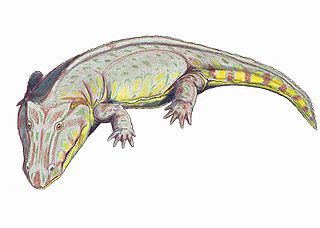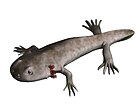
Otsheria is an extinct genus of anomodont, in the infraorder venyukovioidea. It lived in modern-day Russia during the Permian.

Edops is an extinct genus of temnospondyl amphibian from the Early Permian Period. Unlike more advanced temnospondyls of the time, such as Eryops, Edops exhibited an archaic pattern of palatal bones, and still possessed various additional bones at the back of the skull. Edopoids also had particularly big premaxillae and proportionally small external nostrils. Within the clade, the most basal member seems to be Edops from the Early Permian Archer City Formation of the US, a broad-skulled animal with large palatal teeth.

Archegosauridae is a family of relatively large and long snouted temnospondyls that lived in the Permian period. They were fully aquatic animals, and were metabolically and physiologically more similar to fish than modern amphibians. The family has been divided into two subfamilies, the longer-snouted Platyoposaurinae and the shorter-snouted Melosaurinae.

Intasuchus is an extinct genus of temnospondyl amphibian from the Middle Permian of Russia. It is known from a single species, Intasuchus silvicola, which was named in 1956. Intasuchus belongs to the family Intasuchidae and is probably its sole member, although other taxa such as Syndyodosuchus and Cheliderpeton have been assigned to the family in the past. Intasuchus most likely belongs to the group Archegosauroidea, Permian relatives of the large, mostly Mesozoic temnospondyl clade Stereospondyli.

Konzhukovia is an amphibian genus that belongs to an extinct group of temnospondyls, the largest clade of basal tetrapods including about 198 genera, 292 species, and more than half of which were alive during the early Mesozoic period. The animal was a predator that lived about 260 million years ago, and could get up to about three meters in length. Specifically, Konzukovia lived during the Permian, between 252 and 270 million years ago according to the type of rock the fossil was found in. There are three species within this genus, K. vetusta, K. tarda, and K. sangabrielensis, the first two originating from Russia while the latest originating from Southern Brazil. The discovery of this specimen in Southern Brazil provided more evidence to support the idea that during this animals existence, there was a “biological corridor” because of the supercontinent Pangea, allowing these species to be found so far apart from each other. Konzhukovia belongs to the family Archegosauridae, a family consisted of large temnospondyls that most likely compare to modern day crocodiles. Since the discovery of the latest species, K. sangabrielensis, Pacheco proposes that there must be the creation of a new family, Konzhokoviidae, a monophyletic group in a sister-group relationship with Stereospondlyi in order to accommodate the three species. Konzhukovia skulls usually exhibit typical rhinesuchid features including an overall parabolic shape, small orbits located more posteriorly, and the pterygoids do not reach the vomer. These animals were long-snouted amphibians that had clear adaptations made for fish catching, as well as exemplifying aquatic features.

Brachyopoidea is a superfamily of temnospondyls that lived during the Mesozoic. It contains the families Brachyopidae and Chigutisauridae. The earliest records of brachyopids are from the Lower Triassic in Australia. The latest-surviving member of the superfamily is the chigutisaurid Koolasuchus from the Early Cretaceous of Australia.

Lydekkerinidae is a family of stereospondyl temnospondyls that lived in the Early Triassic period. During this time period, lydekkerinids were widely distributed, with putative remains reported from Russia, Greenland, India, South Africa, Madagascar, Australia, and Antarctica. In contrast to most other stereospondyls, lydekkerinids were relatively small-bodied. The type genus is Lydekkerina, the namesake of the family and the best-known lydekkerinid.

Stereospondylomorpha is a clade of temnospondyls. It includes the superfamily Archegosauroidea and the more diverse group Stereospondyli. Stereospondylomorpha was first proposed by Yates and Warren (2000), who found Archegosauroidea and Stereospondyli to be sister taxa in their phylogenetic analysis. A similar clade is Archegosauriformes, named by Schoch and Milner (2000), which includes Stereospondyli and some Permian temnospondyls that are similar in appearance to stereospondyls, including the archegosauroids. However, according to Schoch and Milner's phylogeny, Archegosauroidea is a paraphyletic group of taxa that are successively basal to Stereospondyli, rather than a monophyletic sister taxon.

Limnarchia is a clade of temnospondyls. It includes the mostly Carboniferous-Permian age Dvinosauria and the mostly Permian-Triassic age Stereospondylomorpha. The clade was named in a 2000 phylogenetic analysis of stereospondyls and their relatives. Limnarchia means "lake rulers" in Greek, in reference to their aquatic lifestyles and long existence over a span of approximately 200 million years from the Late Carboniferous to the Early Cretaceous. In phylogenetic terms, Limnarchia is a stem-based taxon including all temnospondyls more closely related to Parotosuchus than to Eryops. It is the sister group of the clade Euskelia, which is all temnospondyls more closely related to Eryops than to Parotosuchus. Limnarchians represent an evolutionary radiation of temnospondyls into aquatic environments, while euskelians represent a radiation into terrestrial environments. While many euskelians were adapted to life on land with strong limbs and bony scutes, most limnarchians were better adapted for the water with poorly developed limbs and lateral line sensory systems in their skulls.
Bukobaja is an extinct genus of mastodonsaurid temnospondyl from the middle Triassic of Russia. It contains a single species, Bukobaja enigmatica. Bukobaja mainly occurs in the Bukobay Svita as part of the Ladinian?-age "Mastodonsaurus fauna", a section of Russian Triassic biostratigraphy characterized by "Mastodonsaurus" torvus. It was also present in the underlying Donguz Svita. Bukobaja appears to be a valid genus similar to, yet distinct from, Mastodonsaurus. Despite appearing to possess several unique features, Bukobaja is still known from very few remains. This has led to difficulties in determining its relations more precisely than "Mastodonsauridae incertae sedis". It has also been compared to trematosaurids.
Gobiops is an extinct genus of temnospondyl from the Jurassic of Mongolia, China, and possibly Kyrgyzstan. The genus is represented by a single species, Gobiops desertus. It was named in 1991 from the Late Jurassic Shar Teeg Beds of Mongolia. Additional material was described in 2005 from the Middle Jurassic Toutunhe Formation in the Junggar Basin of China. Gobiops belongs to the family Brachyopidae. The poorly known genus Ferganobatrachus, named in 1990 from Shar Teeg, is probably synonymous with Gobiops.

Lydekkerina is an extinct genus of stereospondyl temnospondyl. It is the type genus of the family Lydekkerinidae. Fossils have been collected from Early Triassic deposits in South Africa and Australia. The type species is L. huxleyi, first described in 1889. While most other stereospondyls were semiaquatic, Lydekkerina was exclusively terrestrial.

Thoosuchus is an extinct genus of basal trematosauroid trematosaurian temnospondyl. Fossils have been found from Russia and date back to the Early Triassic. It is the type genus of the family Thoosuchidae, formerly called the subfamily Thoosuchinae and placed within Benthosuchidae. The benthosuchids were originally composed of the majority of basal trematosaurian forms regarded as the ancestors of the trematosaurids. Although the genus was first named in 1940, material from one species, E. yakovlevi, was originally tentatively referred to Trematosuchus in 1926.
Vjushkovisaurus is an extinct genus of Middle Triassic archosauriform. It is known from the Anisian-aged Donguz Gorizont in Sol-Iletsk, Orenburg Oblast, Russia. The genus was named in 1982, with the type species being V. berdjanensis. Material has been collected in the Berdyanka II locality from a fossil assemblage called the Eryosuchus Fauna along the Berdyanka River, specifically in a sand-carbonate concretion in the upper part of the main river channel. Vjushkovisaurus is known only from the holotype PIN 2865/62, a partial postcranial skeleton which consists of 12 presacral vertebrae, left humerus, ribs, a fragment of the coracoid and a fragment of the fibula.
Vonhuenia is an extinct genus of basal archosauriform from the Early Triassic of Russia. Fossils have been found in the Vokhminskaya Formation, along the Vetluga River that are Induan in age, making Vonhuenia one of the earliest archosauriforms.

Melosaurinae is an extinct subfamily of temnospondyl amphibians, part of the family Archegosauridae. Most melosaurines are known from Russia, although an unnamed species has been found in Brazil. Unlike the long-skulled archegosaurids of the family Platyoposaurinae, melosaurines have shorter, broadened snouts.
Uralosuchus is an extinct genus of temnospondyl amphibian from the Late Permian of Russia, belonging to the group Archegosauroidea. It is a member of the archegosauroidean subfamily Melosaurinae. Fossils have been found in Orenburg Oblast. Uralosuchus was named in 1993 with the description of the type species U. tverdochlebovae.
Kashmirosaurus is an extinct genus of temnospondyl amphibian known from Permo-Carboniferous deposits in the region of Kashmir. It was originally named by English paleontologist Arthur Smith Woodward in 1905 as a species of Archegosaurus called Archegosaurus ornatus. More recently, the species has been recognized as being distinct from Archegosaurus, and it was placed in its own genus Kashmirosaurus in 1996. An additional species of Archegosaurus, A. kashmiriensis, was named in 1960 from the same deposits in Kashmir, and is now considered synonymous with Kashmirosaurus ornatus.
Aversor is an extinct genus of embolomere which lived in the Early Permian of Russia. It contains a single species, Aversor dmitrievi, which is based on skull and jaw fragments from the Intinskaya Svita near Pechora. It may have been the youngest known eogyrinid, and was the youngest known embolomere until the discovery of Seroherpeton, a Late Permian embolomere described in 2020. Aversor and Seroherpeton both lived at higher latitudes than older embolomeres, suggesting that the group abandoned arid equatorial areas prior to their final demise.
The Rybinskian Gorizont is a Lower Triassic biostratigraphic unit in Western Russia. It is a part of the Vetlugian Supergorizont and corresponds to the earliest part of the Olenekian stage, lying above the late Induan-age Zaplavnian Horizon and below the Sludkian Gorizont. The Rybinskian Gorizont is sometimes known as the Benthosuchus fauna, due to abundant fossils of Benthosuchus, a temnospondyl amphibian index fossil. Related amphibians such as Thoosuchus also increase in abundance, and the interval additionally hosts the oldest fossils of procolophonines and putative true archosaurs in the region.
























